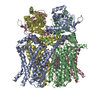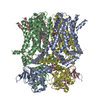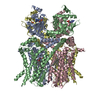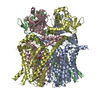+ Open data
Open data
- Basic information
Basic information
| Entry | Database: PDB / ID: 8uc8 | ||||||
|---|---|---|---|---|---|---|---|
| Title | HCN1 nanodisc | ||||||
 Components Components | Potassium/sodium hyperpolarization-activated cyclic nucleotide-gated channel 1 | ||||||
 Keywords Keywords | TRANSPORT PROTEIN / membrane protein / nanodisc | ||||||
| Function / homology |  Function and homology information Function and homology informationintracellular cAMP-activated cation channel activity involved in regulation of presynaptic membrane potential / HCN channels / general adaptation syndrome, behavioral process / HCN channel complex / retinal cone cell development / regulation of membrane depolarization / intracellularly cAMP-activated cation channel activity / apical protein localization / voltage-gated monoatomic cation channel activity / voltage-gated sodium channel activity ...intracellular cAMP-activated cation channel activity involved in regulation of presynaptic membrane potential / HCN channels / general adaptation syndrome, behavioral process / HCN channel complex / retinal cone cell development / regulation of membrane depolarization / intracellularly cAMP-activated cation channel activity / apical protein localization / voltage-gated monoatomic cation channel activity / voltage-gated sodium channel activity / voltage-gated potassium channel activity / potassium channel activity / neuronal action potential / sodium ion transmembrane transport / cAMP binding / cellular response to cAMP / presynaptic active zone membrane / potassium ion transmembrane transport / regulation of membrane potential / postsynaptic membrane / protein homotetramerization / axon / glutamatergic synapse / dendrite / identical protein binding / plasma membrane Similarity search - Function | ||||||
| Biological species |  Homo sapiens (human) Homo sapiens (human) | ||||||
| Method | ELECTRON MICROSCOPY / single particle reconstruction / cryo EM / Resolution: 3 Å | ||||||
 Authors Authors | Kim, E.D. / Nimigean, C.M. | ||||||
| Funding support |  United States, 1items United States, 1items
| ||||||
 Citation Citation |  Journal: Nature / Year: 2024 Journal: Nature / Year: 2024Title: Propofol rescues voltage-dependent gating of HCN1 channel epilepsy mutants. Authors: Elizabeth D Kim / Xiaoan Wu / Sangyun Lee / Gareth R Tibbs / Kevin P Cunningham / Eleonora Di Zanni / Marta E Perez / Peter A Goldstein / Alessio Accardi / H Peter Larsson / Crina M Nimigean /    Abstract: Hyperpolarization-activated cyclic nucleotide-gated (HCN) channels are essential for pacemaking activity and neural signalling. Drugs inhibiting HCN1 are promising candidates for management of ...Hyperpolarization-activated cyclic nucleotide-gated (HCN) channels are essential for pacemaking activity and neural signalling. Drugs inhibiting HCN1 are promising candidates for management of neuropathic pain and epileptic seizures. The general anaesthetic propofol (2,6-di-iso-propylphenol) is a known HCN1 allosteric inhibitor with unknown structural basis. Here, using single-particle cryo-electron microscopy and electrophysiology, we show that propofol inhibits HCN1 by binding to a mechanistic hotspot in a groove between the S5 and S6 transmembrane helices. We found that propofol restored voltage-dependent closing in two HCN1 epilepsy-associated polymorphisms that act by destabilizing the channel closed state: M305L, located in the propofol-binding site in S5, and D401H in S6 (refs. ). To understand the mechanism of propofol inhibition and restoration of voltage-gating, we tracked voltage-sensor movement in spHCN channels and found that propofol inhibition is independent of voltage-sensor conformational changes. Mutations at the homologous methionine in spHCN and an adjacent conserved phenylalanine in S6 similarly destabilize closing without disrupting voltage-sensor movements, indicating that voltage-dependent closure requires this interface intact. We propose a model for voltage-dependent gating in which propofol stabilizes coupling between the voltage sensor and pore at this conserved methionine-phenylalanine interface in HCN channels. These findings unlock potential exploitation of this site to design specific drugs targeting HCN channelopathies. | ||||||
| History |
|
- Structure visualization
Structure visualization
| Structure viewer | Molecule:  Molmil Molmil Jmol/JSmol Jmol/JSmol |
|---|
- Downloads & links
Downloads & links
- Download
Download
| PDBx/mmCIF format |  8uc8.cif.gz 8uc8.cif.gz | 383.4 KB | Display |  PDBx/mmCIF format PDBx/mmCIF format |
|---|---|---|---|---|
| PDB format |  pdb8uc8.ent.gz pdb8uc8.ent.gz | 300.7 KB | Display |  PDB format PDB format |
| PDBx/mmJSON format |  8uc8.json.gz 8uc8.json.gz | Tree view |  PDBx/mmJSON format PDBx/mmJSON format | |
| Others |  Other downloads Other downloads |
-Validation report
| Arichive directory |  https://data.pdbj.org/pub/pdb/validation_reports/uc/8uc8 https://data.pdbj.org/pub/pdb/validation_reports/uc/8uc8 ftp://data.pdbj.org/pub/pdb/validation_reports/uc/8uc8 ftp://data.pdbj.org/pub/pdb/validation_reports/uc/8uc8 | HTTPS FTP |
|---|
-Related structure data
| Related structure data |  42117MC  8uc7C  9bc6C  9bc7C M: map data used to model this data C: citing same article ( |
|---|---|
| Similar structure data | Similarity search - Function & homology  F&H Search F&H Search |
- Links
Links
- Assembly
Assembly
| Deposited unit | 
|
|---|---|
| 1 |
|
- Components
Components
| #1: Protein | Mass: 74643.734 Da / Num. of mol.: 4 / Fragment: UNP residues 1-635,866-890 Source method: isolated from a genetically manipulated source Source: (gene. exp.)  Homo sapiens (human) / Gene: HCN1, BCNG1 / Production host: Homo sapiens (human) / Gene: HCN1, BCNG1 / Production host:  Homo sapiens (human) / References: UniProt: O60741 Homo sapiens (human) / References: UniProt: O60741#2: Chemical | ChemComp-PCW / Has ligand of interest | N | |
|---|
-Experimental details
-Experiment
| Experiment | Method: ELECTRON MICROSCOPY |
|---|---|
| EM experiment | Aggregation state: PARTICLE / 3D reconstruction method: single particle reconstruction |
- Sample preparation
Sample preparation
| Component | Name: HCN1 / Type: COMPLEX / Entity ID: #1 / Source: RECOMBINANT |
|---|---|
| Source (natural) | Organism:  Homo sapiens (human) Homo sapiens (human) |
| Source (recombinant) | Organism:  Homo sapiens (human) Homo sapiens (human) |
| Buffer solution | pH: 8 |
| Specimen | Embedding applied: NO / Shadowing applied: NO / Staining applied: NO / Vitrification applied: YES |
| Vitrification | Cryogen name: ETHANE |
- Electron microscopy imaging
Electron microscopy imaging
| Experimental equipment |  Model: Talos Arctica / Image courtesy: FEI Company |
|---|---|
| Microscopy | Model: FEI TALOS ARCTICA |
| Electron gun | Electron source:  FIELD EMISSION GUN / Accelerating voltage: 200 kV / Illumination mode: OTHER FIELD EMISSION GUN / Accelerating voltage: 200 kV / Illumination mode: OTHER |
| Electron lens | Mode: BRIGHT FIELD / Nominal defocus max: 2900 nm / Nominal defocus min: 1200 nm |
| Image recording | Electron dose: 53.41 e/Å2 / Film or detector model: GATAN K3 (6k x 4k) |
- Processing
Processing
| CTF correction | Type: PHASE FLIPPING AND AMPLITUDE CORRECTION |
|---|---|
| 3D reconstruction | Resolution: 3 Å / Resolution method: FSC 0.143 CUT-OFF / Num. of particles: 447000 / Symmetry type: POINT |
 Movie
Movie Controller
Controller






 PDBj
PDBj





